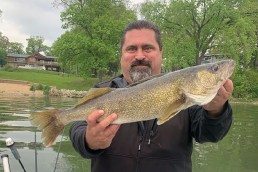Live Bait Rigging for Walleyes
SHARE THIS POST
Phil Piscitello encourages you to get out the live bait this season and get in on some great walleye fishing action.
Minnows, nightcrawlers and leeches have been and still are the preferred baits of walleyes and walleye anglers. There are many ways to present live bait to walleyes. For years, a simple egg sinker, swivel or split shot, and a hook was an effective rig for walleyes. In the early 1970s, Ron Lindner designed a boot-like walking sinker and packaged it with a swivel clip and a leader with an octopus hook, known as the famous Lindy Rig.
The Lindy Rig has been catching walleyes for over 50 years and is just as effective today. They are still sold throughout the Midwest and catch walleyes all season long. They are available with different size hooks for different size minnows, and for nightcrawlers and leeches. You can get them with different sinker weights from 1/16-ounce all the way up to 3/4- and 1 1/2 ounces.
Over the years, refinements were developed to improve upon the basic rig. Sinkers and hooks became available in different colors. In-line floats on the leader to keep the live bait up, off bottom were available on Lindy Rigs to add to the effectiveness.
Later, legendary angler Ron Lindner designed a No Snag Sinker that was very effective over rocky habitat with minimal snags and hang ups. If you did snag the sinker, you could back up and shake your rod, and most times the sinker would release from the snag.
In clear-water systems like Minnesota’s Mille Lacs Lake, tournament walleye anglers would go to very long leaders up to 12 feet long when dealing with spooky, pressured fish. In dark-water systems. a 3- or 4-foot leader is ideal. In snaggy situations, shorter leaders are most effective.
In recent years, different manufacturers have come out with different versions of the walking sinker, some with quick-change designs. All versions of the rig play a key role in all walleye anglers tackle boxes, and it remains an effective presentation throughout the open-water season.
Another effective rig for covering water is the bottom bouncer rig. These were originally known as the Missouri Bottom Bouncer Rig. They were designed out in North and South Dakota on the Missouri River. These sinkers have a wire prong meant to contact bottom and move quickly through snaggy and clean areas as well.
Are you enjoying this post?
You can be among the first to get the latest info on where to go, what to use and how to use it!
The bottom bouncer rig can be fished faster than the Lindy Rig. Different leaders can be used on this rig. In-line spinners are very effective for bottom bouncers. Spinners come in different shapes and sizes. Colorado, Indiana and Willow Leaf blades provide different vibration patterns. The Colorado blade rotates at a 45-degree angle to the line and produces the most vibration. The Indiana blade rotates at a 30-degree angle to the line and has moderate vibration. The Willow Leaf blade rotates at a 15-degree angle to the line and has the least amount of vibration but produces a lot of flash. These need a little more speed to work properly and they excel in clear-water situations.
Spinners rigs have been effective for many years. In some high-pressured systems, it seemed like the spinner would become less effective. A new hook with a special bend known as the Slow Death Hook was born. This hook was designed to be pulled very slowly. Thread a nightcrawler up the hook and pinch it off about 1 inch behind the hook. When pulled slowly through the water, the nightcrawler rotates very slowly, producing a very seductive action.
Mustad was the original producer of the Slow Death Hook; now many manufacturers produce a version of the hook. They are available in different sizes and colors. They are designed to be used with live nightcrawlers. Berkley has a Powerbait version of the ‘crawler called the Pinched Crawler. This rig works well in lakes, rivers and reservoirs.
Another version of the bottom bouncer is the in-line sliding bottom bouncer. These have a plastic clip that slides on the line. You can snap different size weights in the clip for different depths of water without retying. This is good for spooky, light-biting walleyes. When they bite, you can feed them a little line until they get the bait in their mouth. Then sweep the rod forward to set the hook.
In some situations, walleyes will hold several feet off the bottom. A bottom bouncer will be below the fish and lose its effectiveness. In this situation, a three-way rig will be more effective. Tie your dropper to the sinker as long as you need it to get it in the line of sight of the walleyes. Pull your spinners or Slow Death Rigs on the three-way rig. You can use heavy sinkers to fish in deep water, especially in the fall of the year, and boat some true trophy walleyes with this technique.
Looking for more helpful insight to step up your walleye fishing game? You’ll find it in every issue of MidWest Outdoors, available by subscribing on our website.
MWO
SHARE THIS POST
You may also like...
Nothing found.
Did you enjoy this post?
You can be among the first to get the latest info on where to go, what to use and how to use it!
Phil Piscitello
Phil Piscitello has 45 years of experience as a multispecies angler on ice and open water. He is a fishing guide, master charter captain and seminar speaker guiding in northern Illinois and southern Wisconsin. Picitello is also a regular guest on Chauncey’s Great Outdoors radio show and MidWest Outdoors TV show. He has fished all five Great Lakes and many major rivers, lakes, and reservoirs throughout the Midwest.
